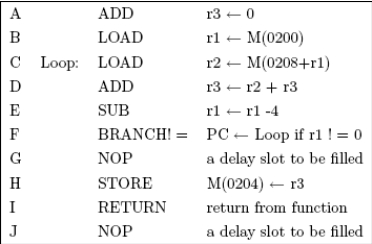You are given a 4-stage pipelined processor as described below.
IF: Instruction Fetch
IDE: Instruction Decode, Register Fetch, ALU evaluation, branch instructions change PC, address calculation for memory access.
MEM: memory access for load and store instructions.
WB: Write the execution result back to the register file. The writeback occurs at the 2nd half of the cycle.
Assume the delayed branching method discussed in Section 4.3. For the following program, assume that the loop will iterate 15 times. Assume that the pipeline finishes one instruction every cycle except when a branch is taken or when an interlock takes place. An interlock prevents instructions from being executed in the wrong sequence to preserve original data dependencies. Assume register bypass from both the IDE output and the MEM output. Also assume that r2 will not be needed after the execution returns.
 (a) Is there any interlock cycle in the program? If so, perform code reordering on the program and show the new program without interlock cycle.
(a) Is there any interlock cycle in the program? If so, perform code reordering on the program and show the new program without interlock cycle.
(b) Derive the total number of cycles required to execute all instructions before and after you eliminated the interlock cycle.
(c) Fill the delay slots. Describe the code reordering and/or duplication performed. Show the same program after delay slot filling. Recall that RETURN is also a branch instruction. Use a ' to mark the new copy of a duplicated instruction. For example, if you duplicated D, name the new copy D'.
(d)Derive the total number of cycles required to execute all instructions after you filled the delay slots.
Definitions:
Good Faith
Good faith denotes honesty or sincerity of intention in fulfilling one's obligations or transacting business.
Franchisor
An individual or company that grants the license to third parties to conduct business under its trademark, business model, and brand.
Franchise Agreement
A legal, binding contract between a franchisor and franchisee, outlining the terms and conditions for the franchise operation.
Rights
Entitlements or freedoms that are guaranteed by law, social norms, or ethical principles.
Q3: Why should there be stride-access for vector
Q3: Insanity is …
Q3: Analyze the following code: <img src="https://d2lvgg3v3hfg70.cloudfront.net/TB2835/.jpg"
Q5: In the short run, which kind of
Q10: What is the estimated shrinkage for most
Q13: Dying a little death, people typically go
Q16: Explain why small and medium cycloalkenes are
Q31: Give the dimensions of an ASME B-size
Q58: Which of the following statements about the
Q136: Give the name of a process where